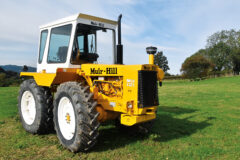The resurrection of an amazing Boothmac Dragsaw
Posted by Chris Graham on 6th February 2024
Merv Cloake recounts the story of buying and then restoring a Boothmac Dragsaw and the stationary engine that powers it.
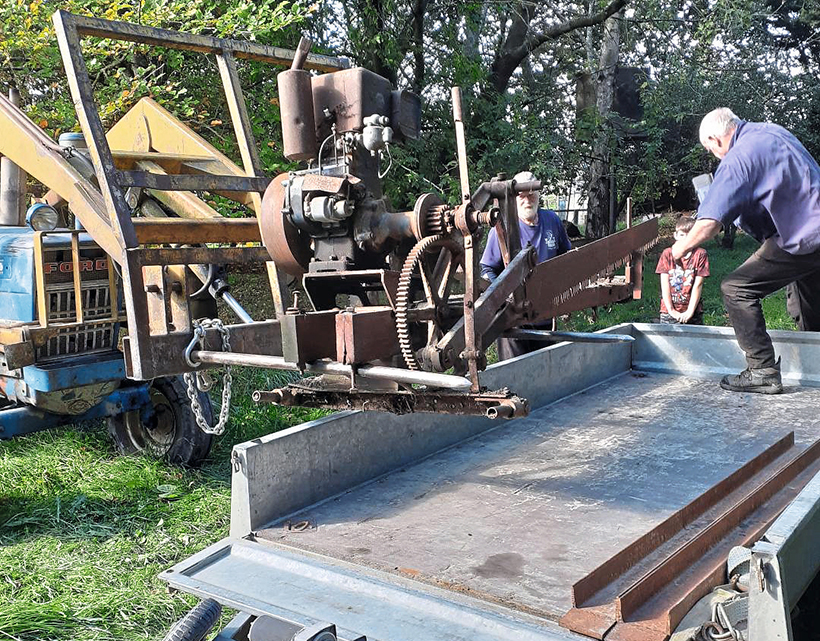
Boothmac Dragsaw: Recovering the saw from under the trees.
Some time ago I wrote a story about the Fowler/Booth Macdonald connection (Issue 564). Since then I have thought that a Boothmac item would fit nicely with the Fowlers in my collection, although I had not actively gone after one.
There were two that came up for sale recently, at a farm auction. The owner had a collection of tractors and engines including two Boothmacs; one restored and the other tidy but unrestored. I was able to view what was being sold beforehand, but was not able to attend the auction so, to cut a long story short. I decided not to leave a bid. The Boothmacs actually sold quite well so nothing was lost. Sometimes it is quite surprising how things turn out. My mate, Irwin, phoned one day and asked if I wanted to have a look at a Boothmac that could be bought.
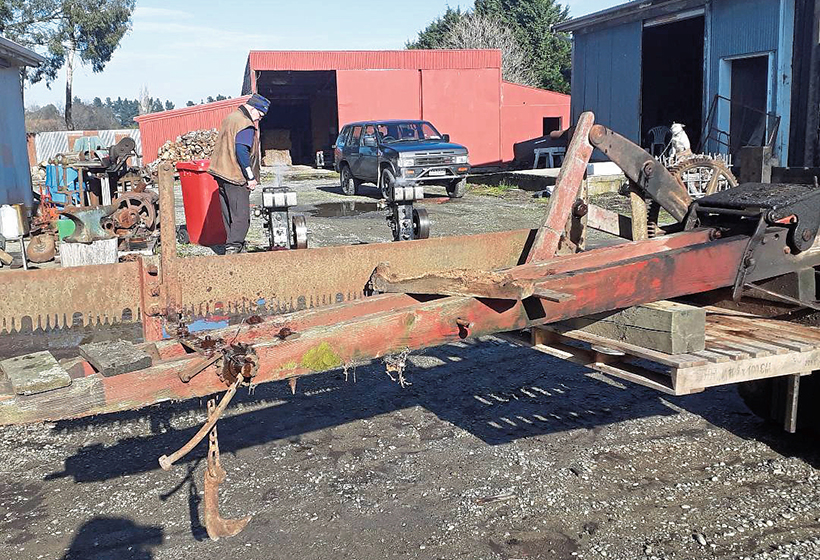
Dismantling the saw. The engine being run can just be seen in the background.
This is where my story actually started. We went to see the engine and found out that there were two, one was on a dragsaw that looked complete, although the wooden beams were not in great shape. There was also the remains (most of) another dragsaw and the other engine, all under the trees where they had lain for many years. The engines appeared to be complete, so an offer was made, and accepted, and a date was made to pick them up. We were very pleased with the outcome.
Collection day
A few days later we were back to collect them and when loaded on the trailer we were told there was another engine in the shed that was in bits because there was something wrong with it, and it could go on the trailer as well; it was an Australian-built XC Cooper that had been part of a sheep-shearing plant (later we got it running). We had a good day. Back home everything was unloaded into my shed and stored until we could find time to work on them as we both had other projects to complete before we wanted to start on them.

Here I am sanding one of the new rails with an air-sander.
Irwin was still working on a Ruston VSH twin-cylinder diesel and I was at a standstill on my projects, so it was time for me to make a start on the two Boothmacs. I dismantled both engines and cleaned them thoroughly, and as usual I assessed their condition. The first one, s/n 277, was on the dragsaw but was seized although not difficult to get apart. It had good valves, bore and rings, but we did find that there had been an attempt to renew the white metal big-end. This was why it was seized. It had nipped-up through lack of oil in the crankcase and there wasn’t a hole through the white metal for oil to get into the bearing. The bearing itself had suffered some damage however, with some care, I was able to recover it. The valves were ground and lapped-in and the cylinder honed with a parallel hone. The dark blue paint generally was good.
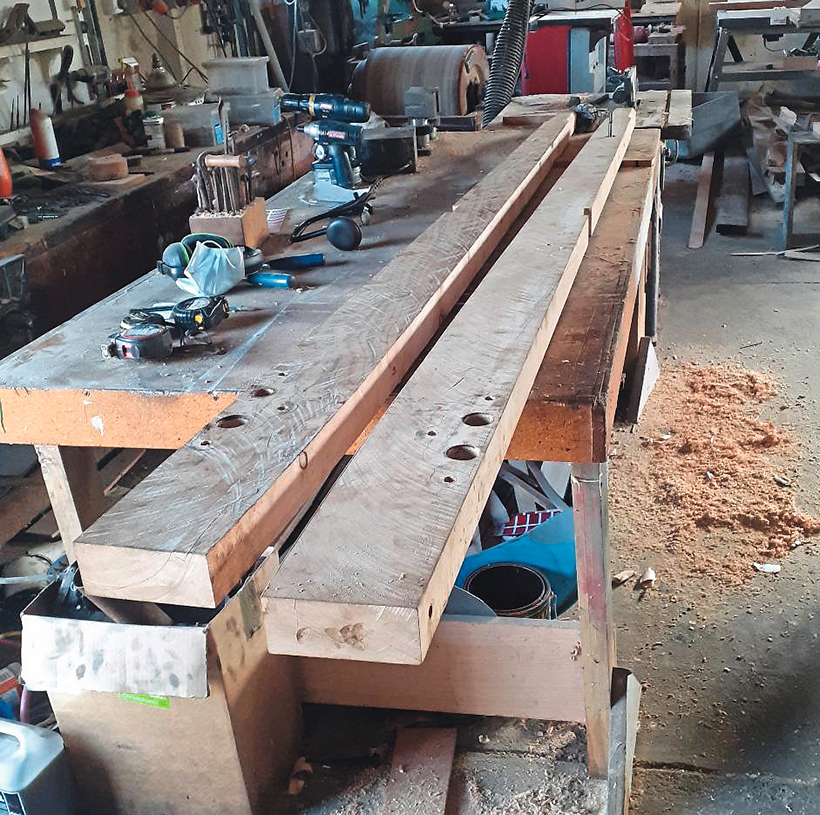
The rails ready to be painted.
Magneto problems
The reassembly of the engine went well, although I did not replace the two-to-one reduction box and output shaft until it was to be mounted on the saw. The fuel tanks on both engines were write-offs, but I was able to save the caps and taps for when I made new tanks to the same pattern. The initial inspection of the Lucas magneto showed a good spark, which was encouraging; the first start went OK, although it was a little hard to start and if the engine was turned off, it would not restart. The magneto was sent away for an overhaul; fortunately the main issue was the condenser which was replaced. When it came back and was fitted to the engine it ran great.
The other engine, s/n 216, had to have work done to the valves and seats as they were in poor condition. The rings and bore, however, were in very good condition and only needed a light hone. Although the magneto proved to be good, I did re-magnetise it. This one had lighter blue paint and quite a lot remained on the engine. Both engines now are in excellent condition and have been given an application of 50-50 boiled linseed oil and turps.

Assembling the saw is underway.
Long trial runs
Both engines have had long trial runs; they run quite well, but do display similar characteristics to Fowler engines, we are happy with them. As we all know, the Fowler engines have quite a lot of ‘pot-metal’ parts but, on the Boothmacs, those parts are aluminium, so in this respect they are superior to Fowlers. These engines are a copy of the Fowler 3¼hp 1PDM.
Eventually it was time to make a start on the actual dragsaw. Neither Irwin nor I have had anything to do with dragsaws, so the research started for any help we could find. Booth Macdonald started making them early in the 1920s.
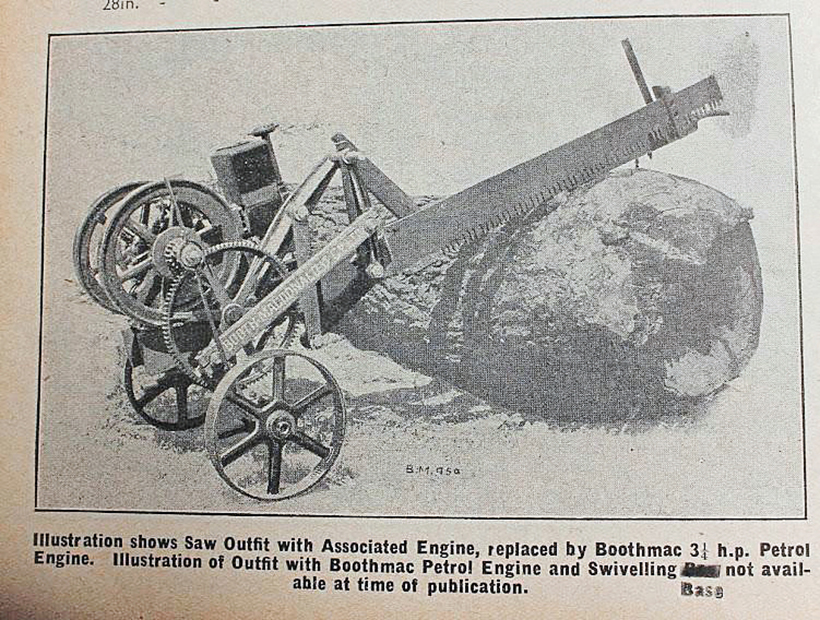
The second version was also powered by an Associated engine, but by now the chain-drive was replaced by gear-drive.
The first ones they built used an Associated (Amanco) engine and the working parts were chain-driven; then later, still using an Associated engine, were gear-driven using a wooden pitman to drive the blade. This set-up is exactly the same as that which was used on the Witte saws. I have no doubt it would have been copied. The next version used a Fowler 1PDM 3¼hp engine with a two-to-one reduction gearbox on the output shaft still using the Witte-style drive, but this time the engine was mounted on a pivoting platform so that the engine could be adjusted for level to suit the size of the log. Finally, from 1942 until 1945, when Fowler engines became unavailable, Booth Macdonald built and fitted their own engines. As we studied the saw we realised that we may not have all the parts, Irwin knew of another one that was in a shed on a farm that he used to work on. We were able to go and have a look at it. Unfortunately, slowly deteriorating, it had a Fowler on it, s/n 70116. From this and the one we had, we had a good idea what we needed to do.
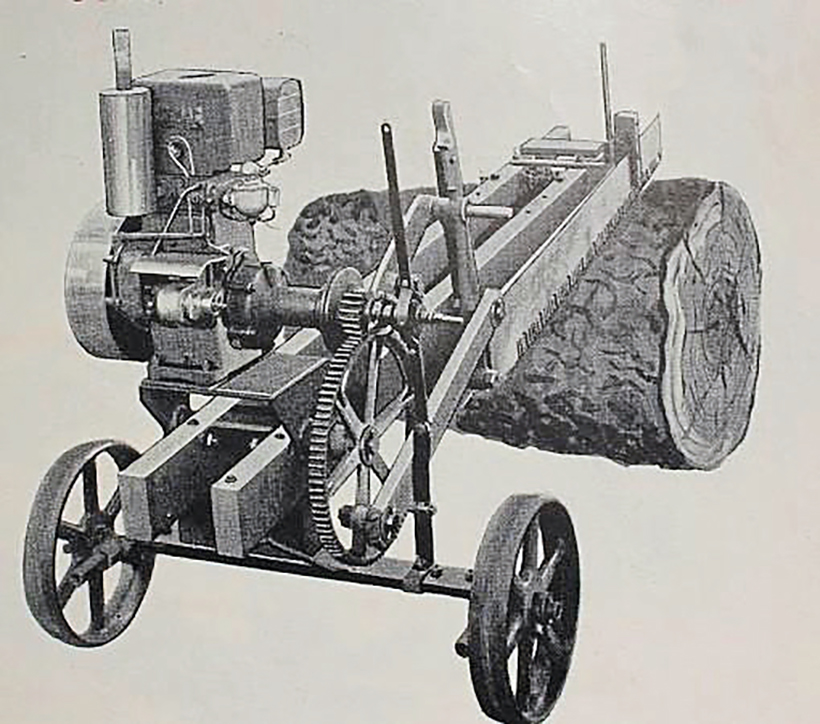
The final version was, like our saw, fitted with a Booth Macdonald engine.
New frame rails
On our saw the rails were not great but I felt it could be easily repaired and made to look as good as new. However Irwin wanted to make new rails as he had found some nice Macrocarpa, a local hardwood, that was very close to the exact size we needed. It was milled 20 years ago and, although rough-sawn on a portable mill, the operator was very good and had done a nice job milling them. They were too close to the exact width we wanted to be dressed, but with an air-operated orbital sander we did get them to come up with a good finish. The rail depth had to be tapered and this was easily done on my Wadkin saw bench and then sanded.
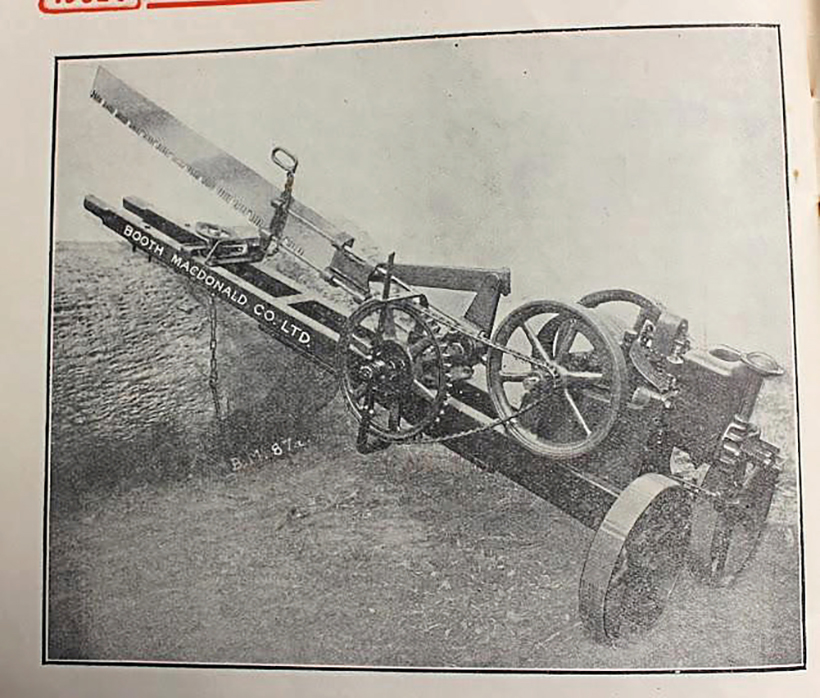
The first versions of the Boothmac dragsaw was fitted with an Associated engine with chain-drive to the pitman arms.
We worked-out that because the rails spacing was less at the saw end than at the engine end, without a pattern it would be nearly impossible to get everything right. Fortunately, the old rails were good enough for this purpose. The holes that went through both rails had to be in line and this was done the ‘old school’ way with a jig, and a brace and bit; it was a lot of fun but we got them perfect and everything lined-up. All the hardware was cleaned up with a wire brush on the angle grinder and once all the rust had been taken off they were coated with boiled linseed oil and turps.
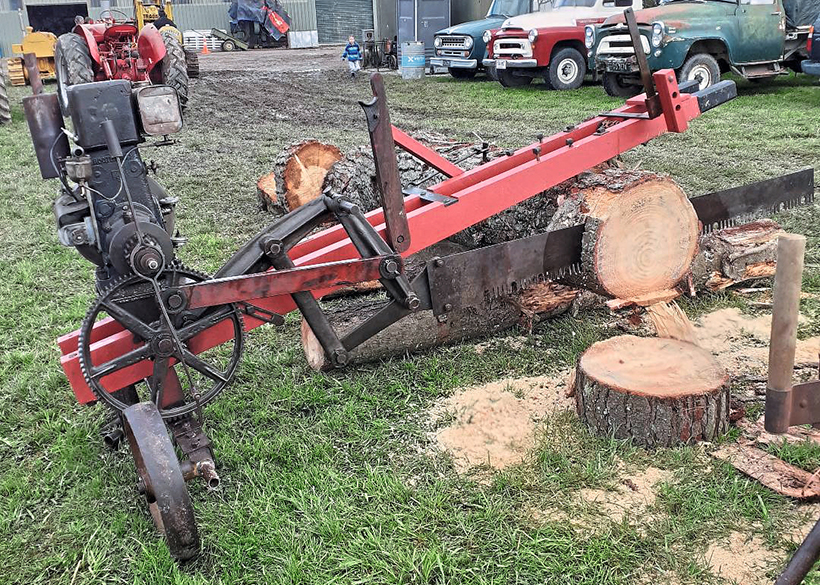
The saw at work.
The pitman still had some of the original ‘barn red’ paint so, with a minor repair, we used it again. I was able to get a very close match to the original paint. The rails were painted before assembly. Once the rails were completed, assembly could begin and the engine, complete with the reduction box, was mounted. When finished, we were able to run the saw by hand without the saw blade, to make sure that everything was correct. The saw blade was in a very good condition; showing very little sign of wear. All it needed was a clean up, sharpening and a little set applied. The saw is designed to cut both ways so the saw dust is cleared both ways by the way the rake teeth are shaped.
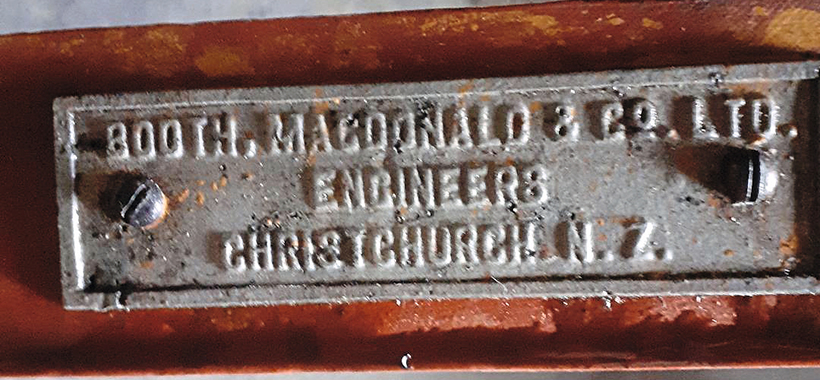
The Boothac maker’s tag.
Cutting that first log
The saw is secured to the log with a winch and a chain with a hook attached that is driven into the log with a sledge hammer; there is a permanently-mounted spike in each rail that is driven into the centre of the log. There were holes on either side of the spikes that research showed longer loose spikes were in the holes. We didn’t have them so Irwin made four in the forge for them, along with another that is on a bar that is fitted to a bracket on a diagonal, to stop lateral movement.
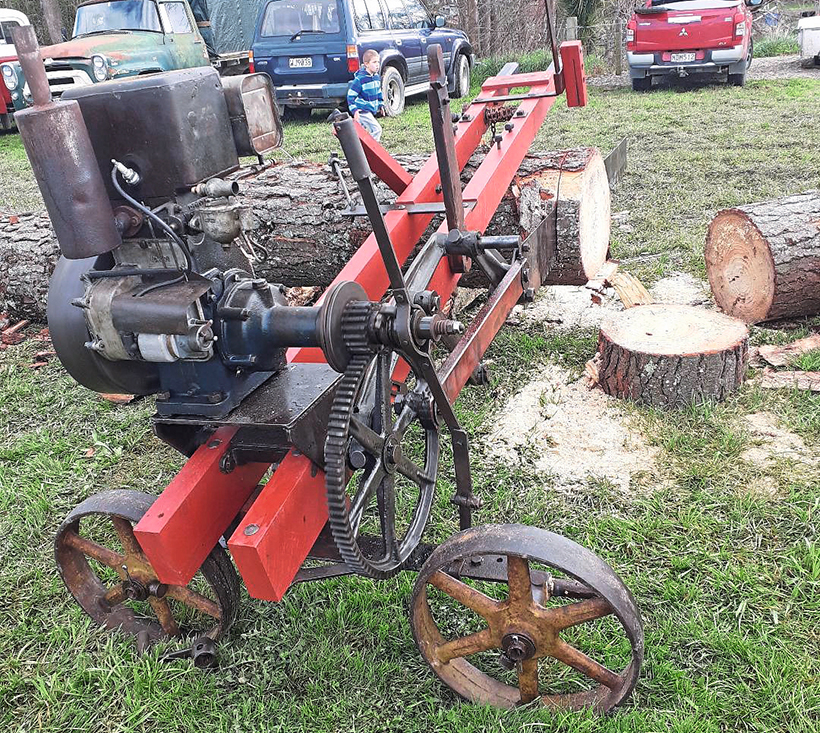
Another view of the saw in action.
We were ready to give it a run; a small log was selected and, to our delight, the saw worked perfectly, easily cutting through it. It had its first outing at a club crank-up on a larger log; it performed faultlessly and attracted a lot of attention. We are very happy with it.
This feature comes the the latest issue of Stationary Engine, and you can get a money-saving subscription to this magazine simply by clicking HERE




